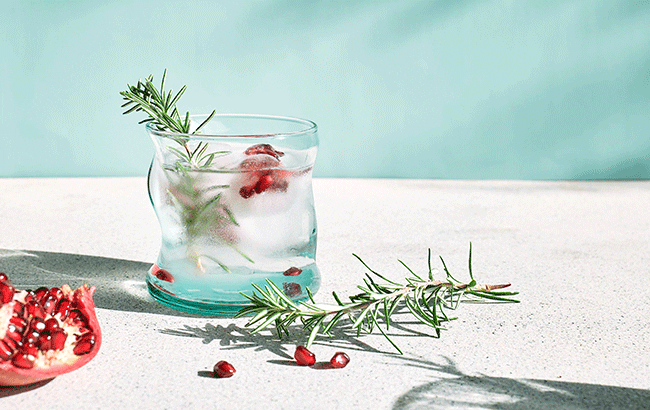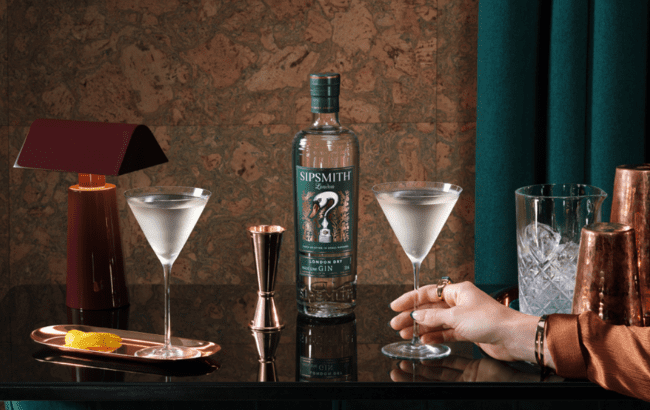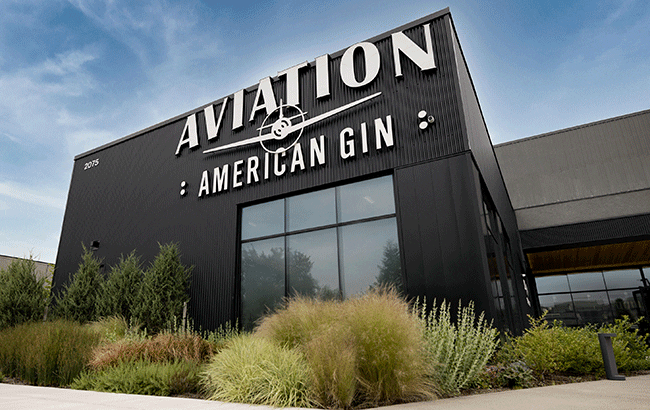Gin prepares for super-premium boom in US
If the great British gin bubble has burst, attention is turning westwards to the tantalising prospect of a super-premium gin explosion in the US.

*This feature was originally published in the December 2023 issue of The Spirits Business magazine.
“We’re weathering the storm,” says Sipsmith’s co-founder, Sam Galsworthy, about the contraction in gin’s biggest market – the UK. “Our share has held up, or increased slightly, but the tide is retreating, and a receding tide takes ships with it.”
A number of brands have already disappeared, and more will surely follow. The UK gin market shrunk by 12% last year according to IWSR Drinks Market Analysis, which forecasts a 6% compound annual growth rate decline through to 2027.
“The peak of this mountain was just before the lockdown period, when every week was like Christmas,” recalls Galsworthy. “People’s home consumption was very experimental, both in terms of flavour and cocktails, and in times of the day.” Since then, “it’s been tough”, he admits. “But I think the place where it’s been hardest hit is in flavoured gins. The classics are what people are retreating to, though I think the sense of adventure in the spirit seems to have waned a little bit.” While UK gin sales may have further to fall, he says: “Our crystal ball is that the market will end up back at 2019.”
In the US there has been no comparable gin boom, at least not yet. While other spirits categories have surged since the Millennium, gin has remained remarkably flat there. Since hitting an all-time high of 19 million cases in 1979, sales settled at just a few bottles short of 11m cases in 2003. Since then they have fluctuated between that figure and the 9.9m they reached in 2021, according to the Distilled Spirits Council of the US (Discus). However, what has changed is the relative share of the different subcategories.
In the past two decades the ‘super-premium’ price band, which includes Hendrick’s, Tanqueray No. Ten, and The Botanist, has experienced a tenfold increase, while the ‘value’ segment that’s home to Gordon’s, Gilbey’s, and Seagram’s Gin, has shrunk by a third. The category is still bottom-heavy in the US, with ‘value’ and ‘premium’ accounting for two thirds of volume in 2021 according to Discus. But it stood at 80% two decades ago.
If anything, that trend is accelerating, with Impact Databank recording double-digit growth in 2022 for six of the top 10 gins in America that retail for US$25 or more a bottle. Way out in front is Hendrick’s, whose US sales jumped by 10% last year to 587,000 cases, followed by a string of brands under 100,000 cases, according to Impact Databank. There is also encouraging news from Nielsen, which puts gin’s growth in the US on-premise last year ahead of whisky, rum and vodka.
“A few years ago, gin wouldn’t have formed part of a standard cocktail programme for a bar in the US. Now, gin is a ‘must-include’ category,” says Daniel Sherry, business development director at Ian Macleod Distillers, owner of Edinburgh Gin. “There are so many gin-based cocktails, but few have really managed to get cut-through.”
As for the most famous example, he says: “Typically, in America if you order a Martini, you can still expect to be served with vodka, though in the more advanced markets of the US you will be asked ‘would you like that Martini with gin?’ That transition in the category says a lot.”
A simple test

Clearly, Sean Connery in all those Smirnoff-sponsored James Bond films has a lot to answer for, though one should be wary of generalisations. “If you’re with a wholesaler and ask to see the craft cocktail bars in the city, I reckon nine out of 10 of them would serve you the right Martini,” says Galsworthy. A well-served gin and tonic is another simple test. “Personally, I’ve been in rural Tennessee and when ordering a G&T you almost get bewilderment from the bar staff,” says Sherry. “I’ve had a G&T in a pint glass with some pre-poured gin, some cubes of ice, and held under a gun for the tonic.”
While Galsworthy shudders at the memory of similar bad experiences in American bars, he believes things are improving. “If you have good ice, a tall glass, tonic in a bottle, a slice that’s fresh off a lemon or lime, and suddenly you’re paying US$3 more just for that serve, that’s premiumisation,” he says. “It’s not just about how premium the spirit is.” A US$3 surcharge sounds ample incentive for bartenders, although weaning America off its beloved soda fountain is challenging. “To get a bar to commit to having an extra ingredient on hand is one of the major hurdles,” he adds.
At Brockmans Gin, CEO Guy Lawrence believes “the G&T moment is still quite late night in the US, and it hasn’t gone mainstream yet”. But there is good news from the country’s top-selling premium tonic water – Fever-Tree. In the company’s latest half-year results to June 2023, CEO Tim Warrillow spoke of “a standout performance in the US, where the brand continues to go from strength to strength”. With net sales up by 40% to £56.1 million (US$70.4m) over the period, the US has become Fever-Tree’s biggest market by value.
Launched in 2015, Isle of Harris gin finally entered the US in May 2021. “I’ve had a lifetime’s experience of working in the US, and I know how complex it is, and how hard it is to get right,” says managing director Simon Erlanger. Buoyed by the brand’s success in Canada, and having found the right importer in the shape of Nisa Imports in Texas, he felt there is space for his US$60 gin in the US. “We hope the combination of a beautiful gin in a beautiful bottle with a really strong story will justify the price,” he says. “And my hope is that nobody ever thinks this is expensive, though I know that sounds counterintuitive.”
So far, Scottish gin Isle of Harris is doing “spectacularly well” in the US, according to Erlanger, who feels the country’s gin market will evolve differently in the UK. “It’s a slower burn,” he says. “The overall category is relatively flat, whereas when we saw the UK boom it was at all levels. So, I think it’s not going to be the same explosion, and what I hope is because of that it won’t be a fad. It will be more sustainable.”
Brockmans Gin, which retails for around US$35, has been in the US since 2015. “We believe there’s a good opportunity in the States,” says CEO Guy Lawrence. “It hasn’t quite happened yet in the way many of us hoped, but we believe it will do at some point.” What is needed, he says, is “to bring a whole new cohort of drinkers into the category, and we think they will come in at the super-premium level.”
The big spirits companies are targeting this space, with a spate of acquisitions of niche premium brands they hope to scale up. Last year Brown-Forman added Gin Mare to its portfolio, having acquired Fords Gin in 2019. Both are looked after by US senior brand manager Alicia Johnson. “With consumers trading up to more premium spirits as a whole, the gin category is seeing growth from this behaviour,” she says. “Most notably in the US, gin is expected to grow by 18% to 2026, with nearly all this growth coming from the ‘premium-plus’ area.”
Yet she concedes that education is needed in the US. “The gin category can be challenging to navigate because the ingredients that are highlighted are often difficult to understand,” she says. “Many people may not understand what a botanical is – and they may also not recognise the name of an ingredient or what these unfamiliar ingredients might taste like.”

In a recent interview with the Shanken News Daily website, Paul Basford, William Grant & Sons USA’s managing director, claimed Hendrick’s has had success “stealing from other white spirits, particularly vodka”, as it’s not “the heaviest, botanical kind of gin”.
Back at Edinburgh Gin, Daniel Sherry also believes in an imminent super-premium gin surge in the US, and reckons one reason we are still waiting is because “there have been a lot of major category trends that have dominated what’s happened at a distributor level in the US. The big three being: RTDs; the premiumisation in Tequila; and celebrity endorsement.” Yet celebrities are embracing gin, notably the Ryan Reynolds-backed Aviation Gin, which was sold to Diageo in 2020 for US$335m, with the promise of US$275m to come over the next decade, dependent on its performance and the actor’s continued marketing input.
It’s a similar deal to Diageo’s acquisition of George Clooney’s Casamigos Tequila in 2017, and if it proves to be half as successful it could do wonders for high-end gin in the US.
Doubtless many brands, possibly squeezed out of the UK, will be looking in the same direction. Not that it’s an easy market to crack. “It’s so competitive, and what you’re really competing for is the mindshare of a distributor salesperson,” says Galsworthy. “And as soon as one gin owner has flown back from America, the next one will be sharing the front seat of the same distributor’s car.”
Related news
The Botanist Distiller's Strength launches in UK
